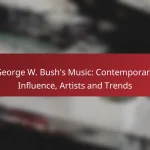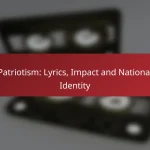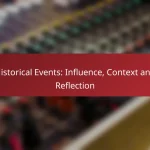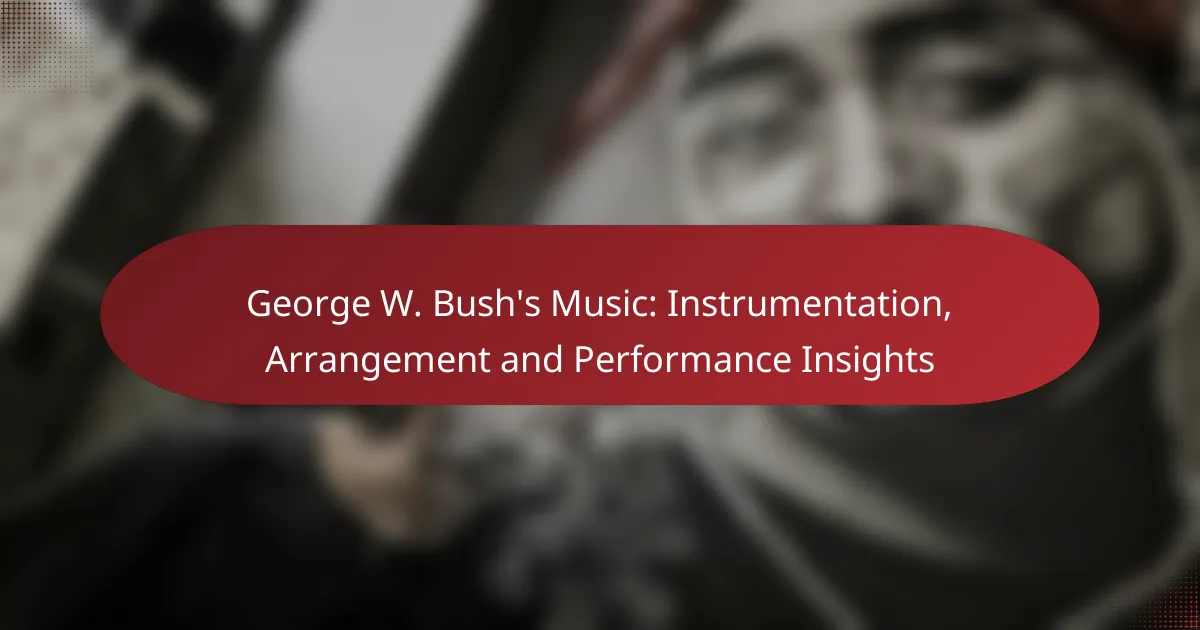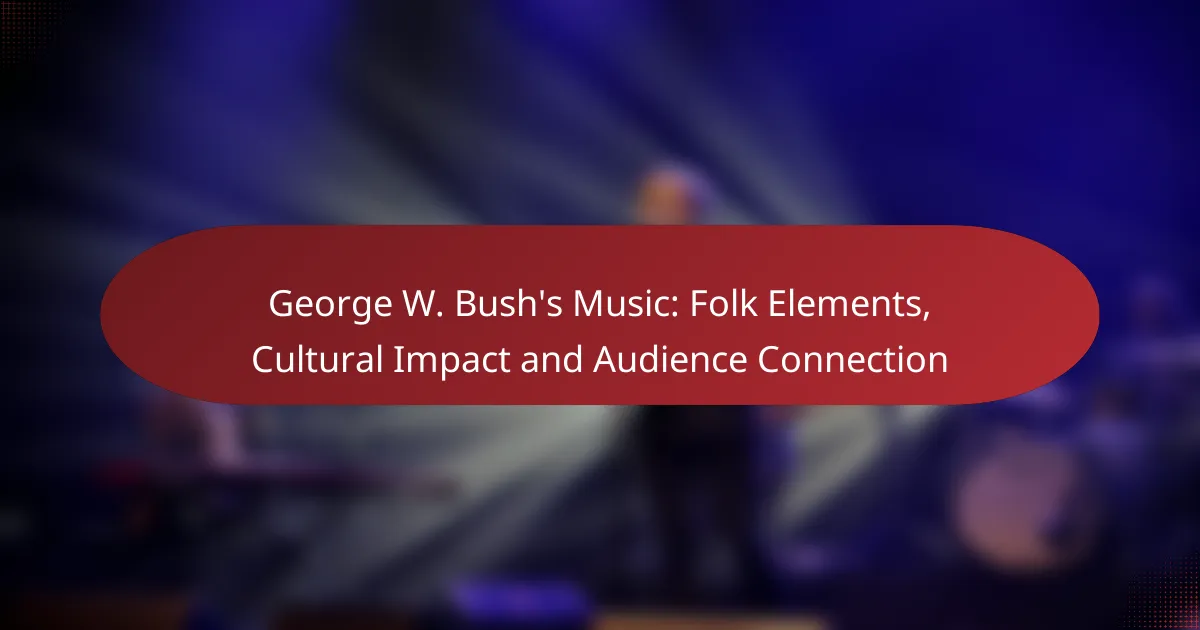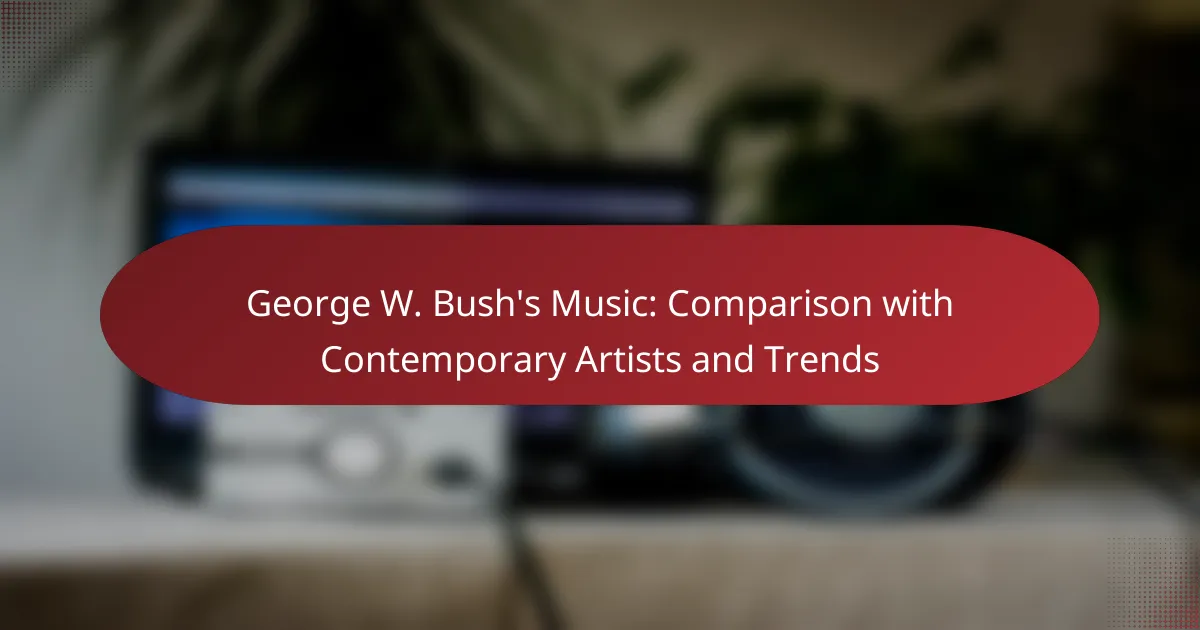George W. Bush’s music features a diverse array of instruments, including guitar, piano, drums, harmonica, and vocals, each contributing to his unique sound. His arrangements prioritize simplicity and accessibility, allowing the melodies and lyrics to take center stage. Through his performances, Bush expresses his passion for music while engaging with audiences, often in the context of charity and community events.

What instrumentation does George W. Bush use in his music?
George W. Bush incorporates a variety of instruments in his music, primarily focusing on guitar, piano, drums, harmonica, and vocals. Each instrument plays a significant role in shaping his musical style and performance approach.
Guitar
The guitar is one of the central instruments in George W. Bush’s musical repertoire. He often plays acoustic guitar, which complements his vocal style and adds a warm, inviting sound to his performances.
Bush’s guitar playing typically features simple chord progressions, making his music accessible and relatable. This straightforward approach allows listeners to connect with the lyrics and melodies easily.
Piano
Piano is another key instrument that George W. Bush utilizes in his music. It provides a rich harmonic foundation and enhances the emotional depth of his songs.
When playing piano, Bush often opts for basic chords and melodies, which align with his overall musical philosophy of simplicity and clarity. This choice helps to maintain focus on the lyrical content of his songs.
Drums
Drums are used sparingly in Bush’s music but serve to add rhythm and drive to certain tracks. The drumming style tends to be straightforward, supporting the overall groove without overwhelming the other instruments.
Typically, the drum patterns are uncomplicated, allowing the guitar and piano to shine while still providing a solid rhythmic backbone for the music.
Harmonica
The harmonica occasionally features in George W. Bush’s performances, adding a unique texture to his sound. Its folk-like quality complements the acoustic elements of his music.
When used, the harmonica often plays simple melodies or fills, enhancing the overall atmosphere without complicating the arrangement. This instrument contributes to a laid-back, Americana vibe in his songs.
Vocals
Vocals are a crucial aspect of George W. Bush’s music, as they convey the emotional core of his songs. His singing style is characterized by a conversational tone, making his music feel personal and relatable.
Bush’s vocal delivery often emphasizes storytelling, allowing listeners to engage with the lyrics. He tends to keep his vocal lines straightforward, which aligns with his overall musical approach of simplicity and accessibility.
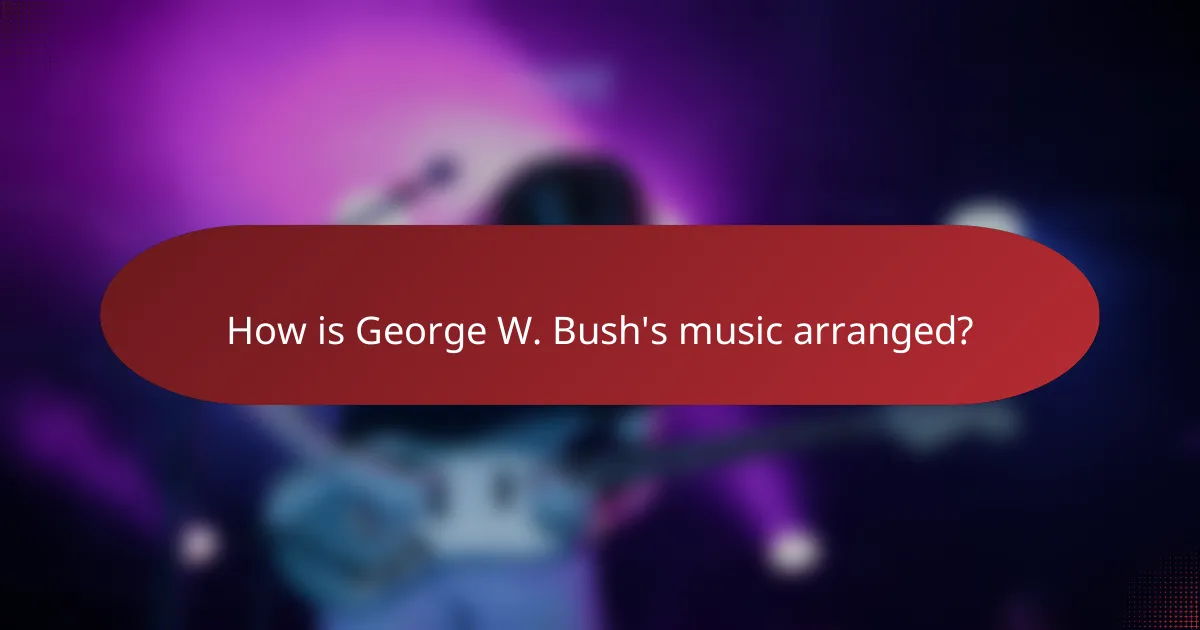
How is George W. Bush’s music arranged?
George W. Bush’s music arrangements are characterized by straightforward structures and a focus on accessibility. The instrumentation often emphasizes simplicity, allowing the melodies and lyrics to shine through without excessive complexity.
Simple chord progressions
Bush’s music typically utilizes simple chord progressions, often revolving around major and minor chords. Common patterns like I-IV-V or I-vi-ii-V are frequently employed, making the songs easy to play and sing along to. This simplicity helps convey the emotional weight of the lyrics without overwhelming the listener.
For example, a typical arrangement might feature a progression such as C-G-Am-F, which is popular in many folk and rock songs. This approach not only enhances memorability but also encourages participation from audiences during performances.
Folk influences
Folk music significantly influences Bush’s musical style, reflecting his personal tastes and cultural background. The arrangements often incorporate acoustic instruments like guitar, banjo, and harmonica, which contribute to a warm, inviting sound. This folk influence aligns with themes of Americana and storytelling present in his lyrics.
Additionally, the use of traditional folk structures, such as verses and choruses that tell a story, reinforces the connection to the genre. This approach resonates with listeners who appreciate the narrative quality of folk music.
Collaborative arrangements
Collaboration plays a vital role in the arrangement of Bush’s music, often involving contributions from various musicians. This teamwork allows for a richer sound, as different instruments and styles blend together to create a cohesive piece. Collaborators may include local artists or friends, fostering a community spirit in the music-making process.
When arranging songs, Bush often seeks input from others to enhance the overall quality and creativity of the work. This collaborative approach not only diversifies the sound but also reflects a shared experience, making the music more relatable to a broader audience.

What are the performance insights from George W. Bush’s music?
George W. Bush’s music performances reflect a blend of personal passion and public engagement, showcasing his love for guitar and country music. His performances often serve to connect with audiences on emotional and social levels, particularly through charity and community events.
Live performances at events
George W. Bush has participated in various live performances at public events, often playing the guitar and singing. These performances are typically informal, allowing him to connect with attendees in a relaxed atmosphere. His choice of songs often resonates with themes of patriotism and unity, making them memorable for audiences.
During his presidency, Bush played at events such as the annual White House Easter Egg Roll and other gatherings, where he often showcased his musical talents alongside family and friends. These performances highlight his commitment to engaging with the public beyond political discourse.
Charity concerts
Charity concerts have been a significant aspect of George W. Bush’s musical engagements, allowing him to leverage his platform for philanthropic causes. He has participated in events that raise funds for veterans, education, and health initiatives, using music as a tool for advocacy.
These concerts often feature a mix of well-known artists and local musicians, creating a collaborative environment that emphasizes community support. The funds raised typically go towards organizations that align with his values, making these performances impactful both musically and socially.
Collaborations with musicians
Collaborations with musicians have been a notable part of George W. Bush’s music journey, often involving artists from various genres. These collaborations not only enhance his musical repertoire but also bring attention to important causes and events.
He has worked with musicians like country singer Toby Keith and participated in events with artists such as Kid Rock. These partnerships often result in performances that blend different musical styles, showcasing Bush’s versatility and willingness to engage with diverse musical influences.
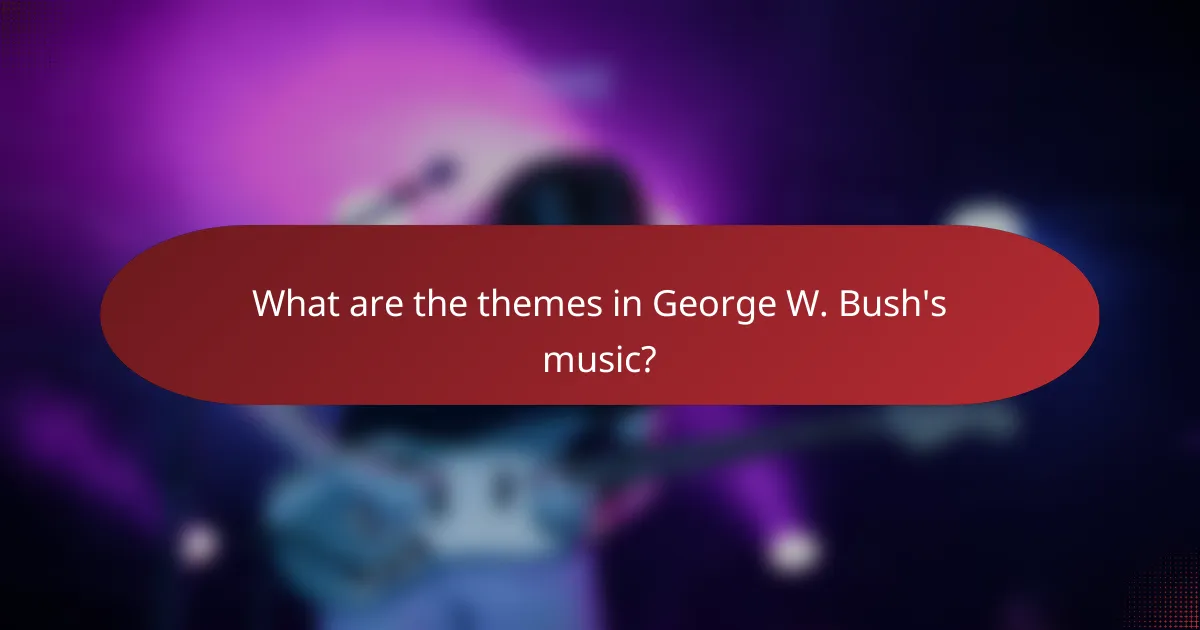
What are the themes in George W. Bush’s music?
George W. Bush’s music often revolves around themes of patriotism, family values, and personal reflections. These themes resonate with his experiences and beliefs, providing insight into his character and the values he holds dear.
Patriotism
Patriotism is a central theme in George W. Bush’s music, reflecting his deep love for the United States. His songs often evoke national pride, celebrating American ideals and the sacrifices made by service members. This theme resonates particularly during national holidays and events, where music serves to unite and inspire audiences.
For example, songs that reference historical events or figures often highlight the resilience and spirit of the American people. This connection to history reinforces a sense of belonging and duty among listeners.
Family values
Family values are another prominent theme in Bush’s music, showcasing his commitment to traditional family structures and relationships. His lyrics frequently emphasize the importance of love, support, and unity within families, reflecting his own upbringing and experiences as a father.
Bush’s songs often convey messages about the significance of nurturing relationships and the role of family in shaping individual character. This theme resonates with many listeners who share similar values and experiences.
Personal reflections
Personal reflections in Bush’s music provide insight into his thoughts and feelings throughout his life. These songs often explore themes of growth, challenges, and the lessons learned along the way. By sharing his personal journey, Bush connects with listeners on a more intimate level.
For instance, songs that discuss overcoming adversity or celebrating milestones can inspire others facing similar challenges. This theme encourages a sense of community and shared experience among listeners, fostering a deeper connection through music.
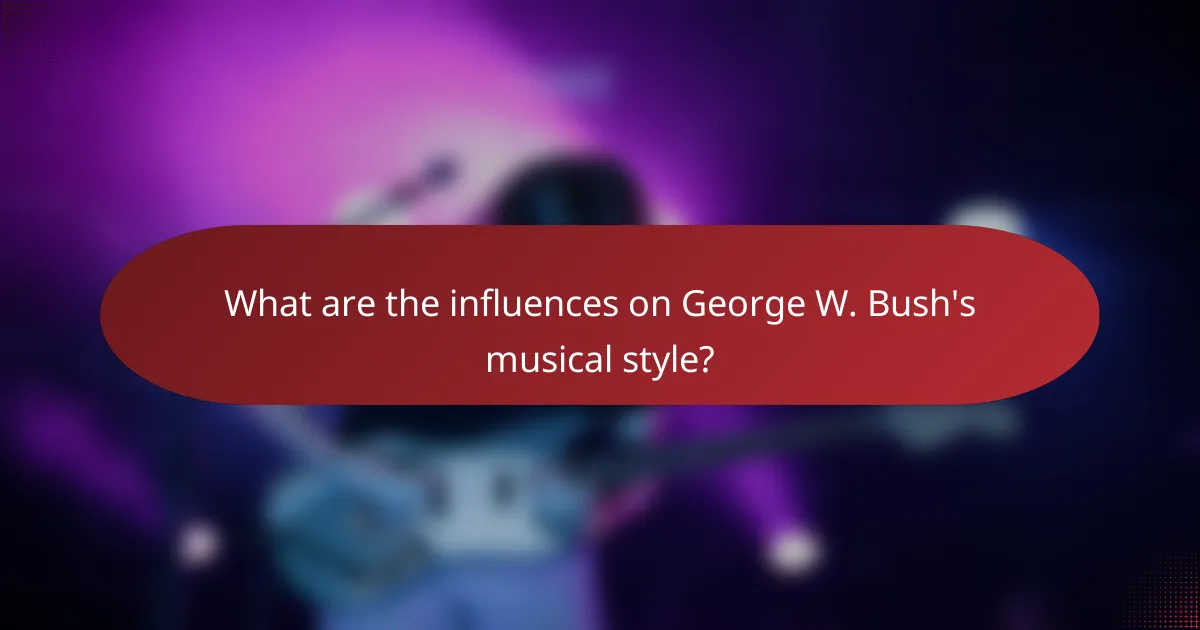
What are the influences on George W. Bush’s musical style?
George W. Bush’s musical style is influenced by a blend of country, rock, and folk genres, reflecting his Texan roots and personal experiences. His preferences showcase a mix of traditional and contemporary sounds, often characterized by storytelling and emotional resonance.
Country Music Influences
Country music plays a significant role in shaping George W. Bush’s musical style. Artists like Willie Nelson and George Jones, who emphasize narrative lyrics and relatable themes, resonate with Bush’s own storytelling approach. This genre’s instrumentation, often featuring guitars, fiddles, and banjos, aligns with his musical preferences.
Rock Elements
Rock music also influences Bush’s style, particularly classic rock from the 1970s and 1980s. Bands like The Eagles and Creedence Clearwater Revival have left a mark on his musical tastes, contributing to a sound that combines upbeat rhythms with reflective lyrics. The electric guitar and strong melodies typical of rock music enhance the emotional depth of his selections.
Folk and Americana
Folk and Americana music further enrich Bush’s musical influences, with artists like Bob Dylan and Johnny Cash exemplifying the storytelling aspect he appreciates. This genre’s acoustic instrumentation and focus on lyrical content resonate with his personal experiences and values, creating a connection to the American narrative.
